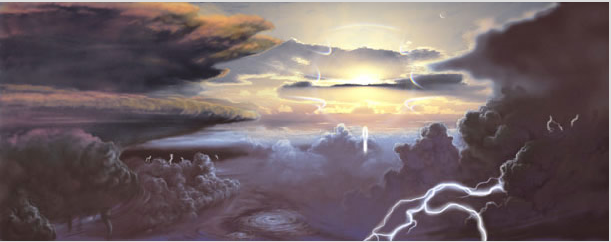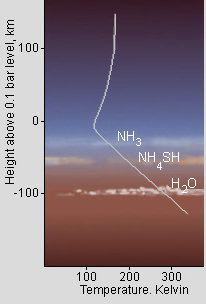Jovian Halos
Jovian Halos: Exploring the Mysteries of Jupiter's Atmosphere
Jupiter, the largest planet in our solar system, is a captivating celestial body with a tumultuous atmosphere. Deep within its turbulent atmosphere, towering clouds of water and ammonium hydrosulfide interact with lightning bolts and weak sunlight, creating a mesmerizing display of atmospheric optics. In this article, we delve into the fascinating phenomenon of Jovian halos, shedding light on their formation and potential similarities to other celestial bodies.
The Enchanting Dance of Light and Crystals
At the heart of Jovian halos lies a layer of ammonia (NH3) crystals, situated at an altitude where the pressure ranges from 0.3 to 0.7 bar and temperatures plummet to approximately -110°C. These upper ammonia crystal clouds are believed to possess a cubic symmetry structure, consisting of tiny cubes, octahedra, and cuboctahedra. Just like their counterparts on Mars formed from CO2 clouds, these crystal structures have the potential to create awe-inspiring halos.
Unraveling the Secrets of Jovian Halos
Although the exact nature of halos formed by the upper ammonia clouds on Jupiter remains a mystery, scientists speculate that they could bear striking similarities to those predicted for Mars. With a slightly higher refractive index than CO2, ammonia crystals have the ability to refract and reflect sunlight, enveloping the sun with their ethereal glow. Thanks to advancements in simulations like HaloSim3, we can now visualize these breathtaking halos that grace the Jovian sky.
A Glimpse into Deeper Layers
As we descend deeper into Jupiter's atmosphere, approximately 20-30 km beneath the ammonia cloud layer, we encounter clouds composed of ammonium hydrosulfide crystals. These crystals are likely influenced by sulfurous or phosphorus polymers and organic compounds, resulting in darkened and possibly colored clouds. Unfortunately, our current understanding of these clouds is limited, preventing us from predicting the nature of their halos.
Earthlike Encounters in the Depths
At approximately 60 km beneath the ammonia cloud layer, Jupiter surprises us with superficially Earthlike clouds composed of water molecules. In this region, pressures reach 5-6 bar, and temperatures resemble those found on our own planet. These water-ice clouds form windblown anvils and cirrus that extend high into the hydrosulfide layer. As a result, their ice crystals have the potential to form halos reminiscent of those seen on Earth.
The Intricacies of Jovian Weather
Jupiter's atmospheric dynamics are complex and dynamic, with different cloud layers interacting and influencing one another. The interplay between the upper ammonia clouds, ammonium hydrosulfide clouds, and water-ice clouds creates a mesmerizing tapestry of atmospheric phenomena. The weak sunlight that penetrates through these layers illuminates the crystals, allowing us to catch glimpses of Earthlike halos amidst the chaos.
Exploring the Similarities
When we compare the Jovian atmosphere to other celestial bodies in our solar system, intriguing similarities emerge. The potential for Jovian halos to resemble those predicted for CO2 clouds on Mars offers us a glimpse into the interconnectedness of atmospheric phenomena across different planets. By studying these similarities, scientists can deepen their understanding of atmospheric optics and gain valuable insights into the complex workings of planetary atmospheres.
In conclusion, Jovian halos present a captivating spectacle within Jupiter's atmosphere. From the upper ammonia clouds with their potential for ethereal halos to the deeper water-ice clouds that offer glimpses of Earthlike beauty, these atmospheric phenomena leave us in awe of the intricate workings of our solar system. Through continued exploration and advancements in simulation technology, we can unravel the mysteries of Jovian halos and gain a deeper appreciation for the wonders that lie beyond our own planet's atmosphere.

Deep within the violent Jovian atmosphere towering water and ammonium hydrosulfide clouds are lit by lightning bolts and weak sunlight gleaming through a high layer of cirrus clouds of ammonia crystals. Ammonia crystals refract and reflect the sunlight to surround the sun with exotic halos. Painting by illustrator and author Ron Miller, he used HaloSim3 to simulate the NH3 halos (large view). ©Ron Miller, reproduced with permission.

Clouds and temperatures in Jupiter's atmosphere.
The upper ammonia crystal clouds are likely tiny cubes, octahedra and cuboctahedra and could form halos similar to those predicted for CO2 clouds on Mars.
The highest clouds in mighty Jupiter's hydrogen/helium atmosphere are a cirrus like layer of ammonia (NH3) crystals where the pressure is 0.3 - 0.7 bar and temperatures about -110 C. Solid ammonia has a cubic symmetry structure and thus could form cloud crystals of similar forms to those of cubic CO2. Ammonia has a slightly greater refractive index than CO2 and is transparent. Halos from the upper Jovian clouds could therefore be very similar indeed to those predicted for tiny Mars.
20-30 km deeper there are clouds formed from ammonium hydrosulfide crystals. They are probably darkened and coloured by sulfurous or phosphorus polymers and organic compounds. Not enough is known to predict their halos.
60 km beneath the ammonia cloud layer we find superficially Earthlike clouds of water molecules. Pressures are 5-6 bar and temperatures are similar to those of Earth. Their windblown anvils and cirrus push high into the hydrosulfide layer and their ice crystals could form Earthlike halos. Their lower levels have liquid droplets and rain or drizzle warm corrosive ammonium hydroxide solution down into the depths.
In summary, Jupiter's high ammonia cloud layer could form halos from its octahedral, cuboctahedral or even rhombic dodecahedral crystals like those predicted for CO2 clouds on Mars . Much deeper, when the weak sun penetrates through, water-ice cirrus might give glimpses of Earthlike halos.
Note: this article has been automatically converted from the old site and may not appear as intended. You can find the original article here.
Reference Atmospheric Optics
If you use any of the definitions, information, or data presented on Atmospheric Optics, please copy the link or reference below to properly credit us as the reference source. Thank you!
-
<a href="https://atoptics.co.uk/blog/jovian-halos/">Jovian Halos</a>
-
"Jovian Halos". Atmospheric Optics. Accessed on December 23, 2024. https://atoptics.co.uk/blog/jovian-halos/.
-
"Jovian Halos". Atmospheric Optics, https://atoptics.co.uk/blog/jovian-halos/. Accessed 23 December, 2024
-
Jovian Halos. Atmospheric Optics. Retrieved from https://atoptics.co.uk/blog/jovian-halos/.